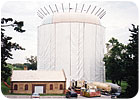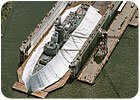
When it comes to abrasives used for general purpose repair and maintenance, paint and rust removal, maintenance applications requiring reduced profiles, new construction, or cleaning surfaces to create a smooth finish, the choices are many. Should you use slag, garnet, steel grit or some other type of abrasive? The choice depends on the application and your objectives.

Back in the Day: Silica Sand
Before the days of regulation by the Air Quality Management District (AQMD), Occupational Safety and Health Administration (OSHA) and others, silica sand was the abrasive of choice. An aggressive aggregate, silica sand proved to be a low-cost and readily available abrasive. All one needed to do was pick up bags of silica sand at a local hardware store and start blasting away.However, as the federal government became more involved and the abrasive blasting industry became more regulated, silica sand became a health and environmental outlaw.
Why? Three words: crystalline silica dust. This substance is the byproduct of blasting with silica sand. Studies conducted by the National Institute for Occupational Safety and Health (NIOSH) show that inhaling finely divided crystalline silica dust in significant quantities (such as those used in abrasive blasting applications) can lead to a disease called silicosis or, in rare cases, cancer.
Silicosis, also known as grinder’s disease or potter’s rot, is a form of occupational lung disease caused by the inhalation of crystalline silica dust. It is marked by inflammation and scarring resulting in nodular lesions in the upper lobes of the lungs, and it is characterized by shortness of breath, fever and cyanosis (bluish skin). The dust becomes lodged in the lungs and is a continuous irritant because silica does not dissolve over time.
Even with all of the studies, health issues and government warnings, blasting with silica sand is still a somewhat common occurrence today.
Slag: A Suitable Silica Substitute
As word got out about the detrimental effects of blasting with sand, the need to find an alternative abrasive with little or no silica content was apparent. Thus, the switch was made to slag as the primary abrasive for one-time usage.
Black Beauty®, Sharpshot®, and Green Diamond® are just a few of the commercial names for various types of slag, a.k.a. “dirt” or “sand.” Angular in composition and relatively inexpensive, slag is available in different grit sizes and provides quick cutting due to its aggressive makeup. Slag abrasives are byproducts resulting from the processing of natural materials - for example, coal slag comes from the combustion of coal in the generation of electricity, copper slag from copper mine excavations, and nickel slag from nickel mine excavations.
Most slags contain less than 1% of free silica content and offer advantages such as a low moisture content, a high degree of etch for the permanent bonding of coatings, the ability to be readily used in standard equipment, inert properties, fast cutting due to sharp, angular edges and high hardness. Slag also is economical, long lasting and generates minimal dust during blasting.
Slag comes in many different grits, from coarse to extra fine. The selection depends on the type of material being blasted and the desired finish.
- Utility grade is coarse and is used for tough blasting jobs.
- Medium grade is used for general-purpose repair and maintenance blasting.
- Fine grade is used for new construction, light paint and rust removal, and for special maintenance applications requiring reduced profiles.
- Extra fine grade is used to clean surfaces and create a smooth finish. This grade typically is employed in brush-off blast applications or in high-pressure water blast systems.

Reclaimable Abrasives
While slag is great for one-time usage, there are instances when a one-time-use abrasive isn’t physically or economically feasible, such as blasting on an island where material has to be brought in on a barge or boat. In such cases, an abrasive is needed that can be reclaimed and reused a designated number of times before it physically breaks down and no longer provides the specified profile required for the job.In an outside blasting operation, unless there is some type of reclaiming system, the abrasive media is simply scooped up, run through some sort of screening system to filter out debris, and put back into the blast pot to be used again.
Probably the most used reclaimable abrasive is garnet. A chemically inert and nonmetallic mineral that is low in free silica content, garnet is a superior blasting media due to its hardness, high specific gravity, low heavy metal content, low dusting and recyclability. Garnet can be reclaimed and reused four to eight times, depending on such variables as the material being blasted, air pressure, blast nozzle size, etc. Garnet is available in many grades:
- #8/12, #16 and #25 are coarse grits used in heavy duty blasting for maximum cutting power, profile and speed.
- #36 and #30/40 provide the standard in control and optimum profile for coatings applications requiring more precision. The resulting surface cleanliness is excellent.
- #50 and #60 are for lighter and less rigorous applications on softer materials, such as aluminum.
The advantage of using a large blast machine is in the recycling capabilities of the abrasive. Though steel grit is costly, it can be recycled 200 times or more before it breaks down. The disadvantages of using a blast machine include the high startup costs of the machine, the high initial cost of the abrasive, and the transportation costs and time required to move the unit to and from the jobsite. The location of the jobsite also needs to be taken into consideration - the blast machine is not very mobile and therefore isn’t practical for use in remote locations. The use of a blasting machine is feasible on large blast jobs, but it is not as conducive to small jobs where time is of the essence.
Lead Abatement
Some outside blasting jobs require the removal of lead-based paint from water storage tanks, bridges, etc. Many types of lead abatement products are available, including products that are blended with the blasting media, sprayed, rolled or brushed on prior to blasting, or sprayed on while blasting.For example, a complex calcium silicate additive* can be incorporated into a typical abrasive medium to create an “engineered abrasive” that is suitable for removing lead-based paint systems from most surfaces. When water is added, the lead in the residual waste is chemically stabilized so that it does not exhibit the Resource Conservation and Recovery Act (RCRA) toxicity characteristic (5.0 mg/L) for lead.
Another water-based formula** uses a patented treatment chemistry to convert lead to a highly insoluble inorganic compound. The chemical dosage can be tailored to treat any level of lead cost effectively below the RCRA toxicity characteristic or the universal treatment standard (0.75 mg/L). The treated material remains stable under all “real world” and standard laboratory leaching tests. Once blasting is complete, the combined waste debris can be tested for lead content and disposed of at a landfill.
Because the formula is water-based and pH neutral, it does not create any worker contact, wastewater or material handling problems. Sediment treated with the premium version of the product is nonhazardous and can be managed as a RCRA Subtitle D solid waste. The product therefore provides significant cost savings through reduced testing, transportation and disposal costs. Additional savings are realized by eliminating the preparation and tracking of hazardous waste manifests.
When all is said and done, there are many choices for abrasives for outside blasting applications. Choosing the correct abrasive for your particular job can make all the difference in achieving a cost-effective, high-quality finish.
For more information about blasting abrasives, visit www.blastcoat.com.
*Blastox®, manufactured by the TDJ Group, Inc., Cary, IL.
**Enviro-Prep®, manufactured by Hoffer’s Coatings Inc., Wausau, WI.
SIDEBAR: Blasting Abrasives at a Glance
-
Slag - Byproducts resulting from the processing of natural materials, with little or no silica content. Useful for one-time applications where reclaim is of little consequence.
-
Garnet - A chemically inert and non-metallic mineral for applications requiring reclaim.
- Steel - Used in recovery systems and for lead-based paint removal.
SIDEBAR: A Note about Containment
Some outside blasting jobs require the blasting area to be contained. Containment is achieved by erecting a frame that allows a material to be draped over it to enclose the blasting area. Commonly used containment materials include nylon and vinyl netting, screen, tarps, and shrink-wrap.Scaffolding placed within the containment area allows the blasters to move freely. As one area is completed, the containment system and scaffolding are simply moved to the next area to be blasted.



